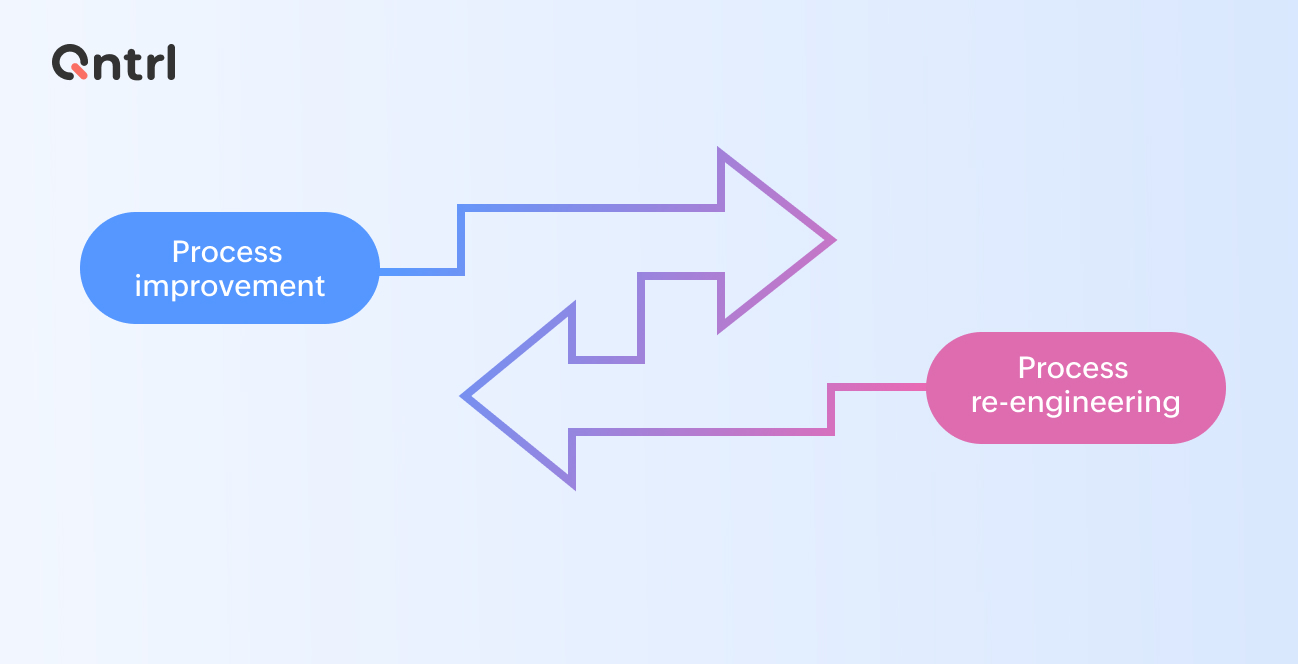Process improvement and process re-engineering are two approaches that organizations can use to optimize their processes and drive operational excellence
This article will discuss these two approaches, their differences, and how businesses can choose the right approach that suits their unique needs andgoals.
Process improvement: Defining the approach
Process improvement is identifying and eliminating inefficiencies in existing processes to improve theirefficiency, effectiveness, and quality. It is a continuous improvement approach focusing on incremental changes to achieve better results. Process improvement is a data-driven approach that relies on key performance indicators (KPIs) and process metrics to measure progress.
The need for process improvement
Businesses need to improve their processes for several reasons:
- Process improvement can help companies reduce costs by eliminating waste and optimizing resources.
- It can improve the quality of products and services, enhancing customer satisfaction and loyalty.
- It can improve thespeed of operations, enabling businesses to respond faster to changing market conditions.
Process improvement techniques
Businesses can use several process improvement techniques to optimize their operations.
- Process mapping: A visual tool that helps organizationsmap their processes, identify inefficiencies, and streamline operations.
- Root cause analysis: A method for identifying the underlying causes of problems and developing solutions to address them.
- Six Sigma: A data-driven approach for improving quality and reducing defects.
- Lean: A methodology for optimizing processes by eliminating waste and maximizing value.
- Total quality management: An approach focusing on continuous improvement and customer satisfaction.
Process re-engineering: Understanding the approach
Process re-engineering is a radical approach to process optimization that involves breaking down existing processes and rebuilding them from scratch to create new, more efficient processes. It aims to achieve significant improvements in performance, quality, and cost effectiveness. Process re-engineering often requires a fundamental change in the organization's structure, culture, and operating model.
Process re-engineering techniques
Businesses can use several process re-engineering techniques to transform their processes. These include:
- Business process modeling: A technique for visualizing and analyzing business processes to identify inefficiencies and opportunities for improvement.
- Benchmarking: A process for comparing an organization's performance with its peers to identify areas for improvement.
- Technology adoption: Adopting new technologies to automate processes, increase efficiency, and reduce costs.
Comparing process improvement and process re-engineering: Key differences and similarities
While process improvement and re-engineering aim to optimize processes, their approach, scope, and outcome differ.
Process improvement focuses on incremental improvements, while process re-engineering aims for radical transformation.
Process improvement is less disruptive and less expensive, while process re-engineering can be costly and time consuming.
However, both approaches require a data-driven,collaborative, and customer-focused mindset to be successful.
Deciding between process improvement and process re-engineering
- Process improvement involves incremental changes to an existing process to enhance efficiency and effectiveness.
- Process re-engineering involves completely overhauling the existing process to achieve significant performance improvements.
- The scope of change in process improvement is usually limited, while it is more extensive in process re-engineering.
- Process improvement requires fewer resources than process re-engineering.
- Process re-engineering requires significant resources and involves higher risks compared to process improvement.
- The organizational culture plays a crucial role in deciding which approach to adopt.
- A combination of both approaches may be the best solution in some cases.
A tool for process improvement and process re-engineering
Qntrl is a tool that helps businesses with both process improvement and process re-engineering. It uses machine learning algorithms to identify inefficiencies and opportunities for improvement, enabling data-driven decisions.
Qntrl's key features include process mapping, real-time monitoring, advanced analytics, and collaboration. These features enable businesses to identify bottlenecks, inefficiencies, and areas for improvement; track performance metrics; analyze process data; and collaborate on optimization projects.
Qntrl can help businesses significantly improve process efficiency, quality, and cost effectiveness. It's a flexible and scalable platform that can accommodate process improvement and process re-engineering projects, making it an ideal tool for businesses looking to optimize their processes.
Choosing the right approach for your business
So, when a company wants to improve its processes, it can either improve them bit by bit or completely overhaul them.
The best choice depends on things like how big the problem is, how much time and money they have, and their company culture. It's essential to think carefully about each option's pros and cons before deciding.
Improving processes means making small changes over time, while re-engineering them means making significant changes simultaneously. Either way, it's essential to use data, work together as a team, and keep the customer in mind to ensure successful changes.
We can also help you with this.Register for a free demo to figure out what is best for your business.








